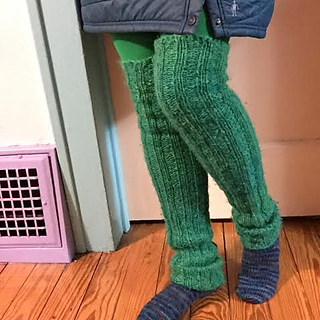patterns >  Lynn DT Hershberger's Ravelry Downloads
Lynn DT Hershberger's Ravelry Downloads
> Tall and Toasty Stay-up Legwarmers






Tall and Toasty Stay-up Legwarmers
Stand Tall; Walk Tall; Stay Warm!
Sometimes you need style. Sometimes you just plain need to stop shivering. These legwarmers have you covered in either situation.
Gauge: (worsted-weight yarn) 18 st / 4 inches in pattern (K2P2 ribbing); yarn that typically knits in stockinette at 5 st/in.
Needles: 1 set (of four) size 8 US/5mm double-pointed needles (DPNs) or the size with which you achieve gauge.
Yarn: For over-the-knee length shown, 200gm of resilient, stretchy worsted-weight yarn. Yarns with mostly wool or an elastane/lycra content will work best (they will stay up better).
Pictured is Ella Rae Classic Worsted.
Yarn Substitutes: Springy yarns rated 5 st/in.; at least 25% wool (or contain lycra/elastane) with about 220 yd in 100gm.
Sizes/Circumference: As written, legwarmer meas. 8 in. unstretched/ 22 in. stretched. My legs above measure 14 inches circ. above the knee and the warmers stay up but are roomy. Add/subtract in multiples of 4 stitches if needed, should change size by up to 2 inches per 4 stitches, stretched.
Sizes/Height: My warmers measure 27.5 in. high off the leg. On my slim legs (14 inches circ. just above the knee) you can see that they retain much of that height when worn. On a friend’s goddess-like legs, they still fit comfortably but pull up to just above the knee without much wiggle room at the ankle and without a turned-over top cuff.
Notions/Extras: Large-eyed needle for finishing ends.
Important Note: Negative Ease and Yarn Choice
Many patterns for legwarmers do not take into account the essential concept of negative ease. Negative ease is crucial in order that legwarmers do not fall down while wearing. Do not make them a size bigger “Just in case” or you may end up with saggy tubes around your ankles. Be sure you are working with a springy, stretchy yarn (wool is best) rather than luxe and droopy (alpaca, silk or 100% cotton will be a disappointment).
199934 projects
stashed
110377 times
17160 projects
stashed
11345 times
- First published: December 2015
- Page created: December 22, 2015
- Last updated: October 27, 2020 …
- visits in the last 24 hours
- visitors right now




